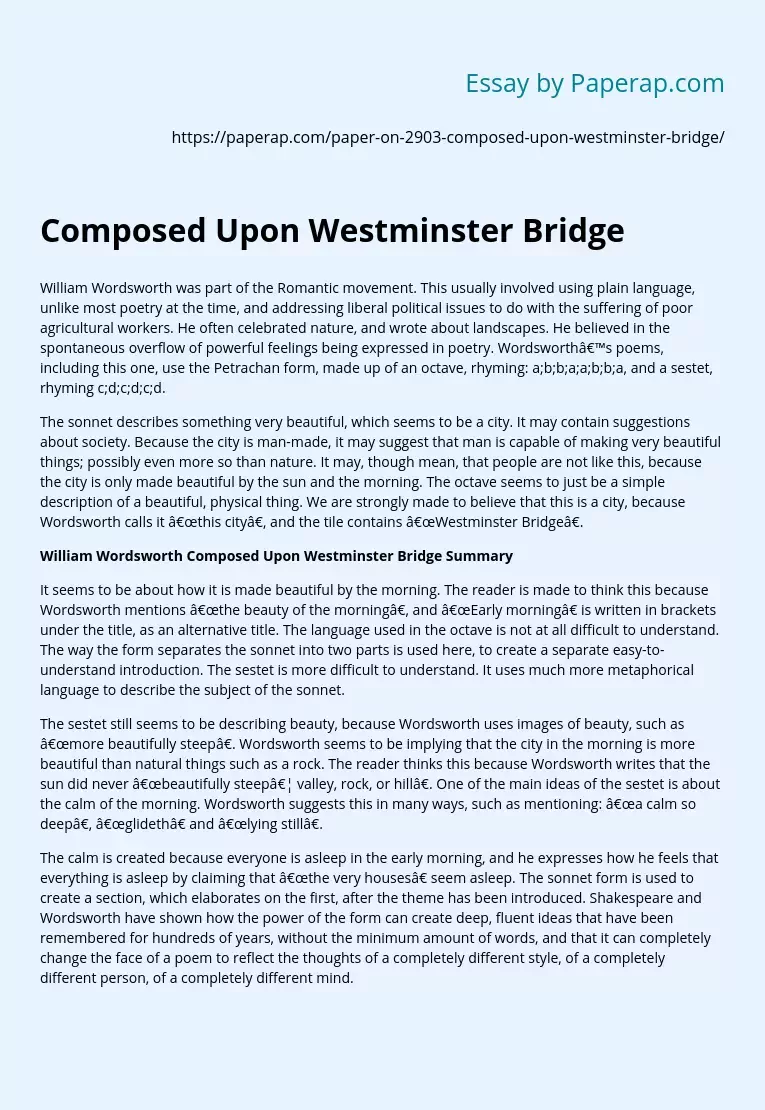William Wordsworth Composed Upon Westminster Bridge Summary
William Wordsworth was part of the Romantic movement. This usually involved using plain language, unlike most poetry at the time, and addressing liberal political issues to do with the suffering of poor agricultural workers. He often celebrated nature, and wrote about landscapes. He believed in the spontaneous overflow of powerful feelings being expressed in poetry. Wordsworth’s poems, including this one, use the Petrachan form, made up of an octave, rhyming: a;b;b;a;a;b;b;a, and a sestet, rhyming c;d;c;d;c;d.
The sonnet describes something very beautiful, which seems to be a city. It may contain suggestions about society. Because the city is man-made, it may suggest that man is capable of making very beautiful things; possibly even more so than nature. It may, though mean, that people are not like this, because the city is only made beautiful by the sun and the morning. The octave seems to just be a simple description of a beautiful, physical thing.
We are strongly made to believe that this is a city, because Wordsworth calls it “this city”, and the tile contains “Westminster Bridge”.
It seems to be about how it is made beautiful by the morning. The reader is made to think this because Wordsworth mentions “the beauty of the morning”, and “Early morning” is written in brackets under the title, as an alternative title. The language used in the octave is not at all difficult to understand. The way the form separates the sonnet into two parts is used here, to create a separate easy-to-understand introduction.
The sestet is more difficult to understand. It uses much more metaphorical language to describe the subject of the sonnet.
The sestet still seems to be describing beauty, because Wordsworth uses images of beauty, such as “more beautifully steep”. Wordsworth seems to be implying that the city in the morning is more beautiful than natural things such as a rock. The reader thinks this because Wordsworth writes that the sun did never “beautifully steep… valley, rock, or hill”. One of the main ideas of the sestet is about the calm of the morning. Wordsworth suggests this in many ways, such as mentioning: “a calm so deep”, “glideth” and “lying still”.
The calm is created because everyone is asleep in the early morning, and he expresses how he feels that everything is asleep by claiming that “the very houses” seem asleep. The sonnet form is used to create a section, which elaborates on the first, after the theme has been introduced. Shakespeare and Wordsworth have shown how the power of the form can create deep, fluent ideas that have been remembered for hundreds of years, without the minimum amount of words, and that it can completely change the face of a poem to reflect the thoughts of a completely different style, of a completely different person, of a completely different mind.
William Wordsworth Composed Upon Westminster Bridge Summary. (2019, Dec 05). Retrieved from https://paperap.com/paper-on-2903-composed-upon-westminster-bridge/

